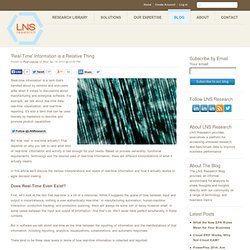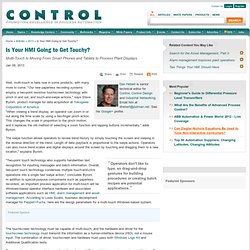

'Real-Time' Information is a Relative Thing. 'Real-Time' Information is a Relative Thing 'Real-time information' is a term that's bandied about by vendors and end-users alike when it comes to discussions about manufacturing and enterprise software.

For example, we talk about real-time data, real-time visualization, and real-time reporting. It's also a term that can be used liberally by marketers to describe and promote product capabilities. But how ‘real’ is real-time actually? That depends on who you talk to–and what kind of ‘real-time’ information and activity is fast enough for your needs. In this article we’ll discuss the various interpretations and layers of real-time information and how it actually relates to agile decision making. Does Real-Time Even Exist? First, let’s look at the fact that real-time is a bit of a misnomer.
There tend to be three clear levels in terms of how real-time information is collected and reported: All Can Be Lost: The Risk of Putting Our Knowledge in the Hands of Machines - Nicholas Carr. We rely on computers to fly our planes, find our cancers, design our buildings, audit our businesses.

That's all well and good. But what happens when the computer fails? On the evening of February 12, 2009, a Continental Connection commuter flight made its way through blustery weather between Newark, New Jersey, and Buffalo, New York. As is typical of commercial flights today, the pilots didn’t have all that much to do during the hour-long trip. The captain, Marvin Renslow, manned the controls briefly during takeoff, guiding the Bombardier Q400 turboprop into the air, then switched on the autopilot and let the software do the flying. The crash, which killed all 49 people on board as well as one person on the ground, should never have happened.
The Buffalo crash was not an isolated incident. And that, many aviation and automation experts have concluded, is a problem. The experience of airlines should give us pause. Doctors use computers to make diagnoses and to perform surgery. Welcome to Forbes. When 'Smart Homes' Get Hacked: I Haunted A Complete Stranger's House Via The Internet.
YouTube. LittleBits hands-on: LEGO blocks for future electrical engineers. We haven't checked in with littleBits in quite some time and, honestly, it was a bit of a surprise to find the electronic tinker toys hiding in a quiet corner of the floor at Toy Fair this year.

The property has grown quite a bit in the past few years. For one, it's no longer a "project" but an actual shipping product. And in the last year founder Ayah Bdeir has turned it from a great concept into an actual company with serious investors. For those of you unfamiliar with littleBits, the goal is to do for electronics what LEGO did for structural engineering. The small color coded "blocks" snap together with magnets allowing even a novice to create a functioning circuit in seconds. The latest version of the platform, v0.3, debuted just a couple of months ago and not only brings new pieces to the littleBits universe, but also adds legs to the blocks for improved stability when piecing together your projects.
LittleBits hands-on See all photos 19 Photos. Operator Interface: Is Your HMI Going to Get Touchy? Well, multi-touch is here now in some products, with many more to come.

"Our new paperless recording systems employ a two-point resistive touchscreen technology with pinch in and out, and touch-and-swipe actions," says Steve Byrom, product manager for data acquisition at Yokogawa Corporation of America. "When viewing a trend display, an operator can zoom in or out along the time scale by using a two-finger pinch action. This changes the scale in proportion to the pinch motion, and it replaces the old method of selecting a zoom function and tapping buttons incrementally," adds Byrom.
The swipe function allows operators to review trend history by simply touching the screen and swiping in the reverse direction of the trend. Length of data playback is proportional to the swipe actions. “Operators don't like to type, so drag-and-drop gestures for building procedures or creating batch recipes are potential applications.” The operating system must interpret the information as HID.